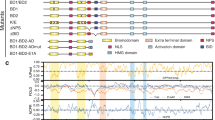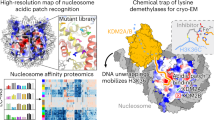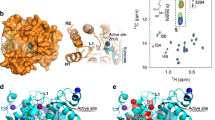Abstract
CBP and p300 are histone acetyltransferases (HATs) that associate with and acetylate transcriptional regulators and chromatin. Mutations in their catalytic 'cores' are linked to genetic disorders, including cancer. Here we present the 2.8-Å crystal structure of the catalytic core of human p300 containing its bromodomain, CH2 region and HAT domain. The structure reveals that the CH2 region contains a discontinuous PHD domain interrupted by a RING domain. The bromodomain, PHD, RING and HAT domains adopt an assembled configuration with the RING domain positioned over the HAT substrate-binding pocket. Disease mutations that disrupt RING attachment led to upregulation of HAT activity, thus revealing an inhibitory role for this domain. The structure provides a starting point for understanding how chromatin-substrate targeting and HAT regulation are coupled and why mutations in the p300 core lead to dysregulation.
This is a preview of subscription content, access via your institution
Access options
Subscribe to this journal
Receive 12 print issues and online access
$189.00 per year
only $15.75 per issue
Buy this article
- Purchase on Springer Link
- Instant access to full article PDF
Prices may be subject to local taxes which are calculated during checkout





Similar content being viewed by others
Accession codes
References
Goodman, R.H. & Smolik, S. CBP/p300 in cell growth, transformation, and development. Genes Dev. 14, 1553–1577 (2000).
Merika, M., Williams, A.J., Chen, G., Collins, T. & Thanos, D. Recruitment of CBP/p300 by the IFNβ enhanceosome is required for synergistic activation of transcription. Mol. Cell 1, 277–287 (1998).
Panne, D. The enhanceosome. Curr. Opin. Struct. Biol. 18, 236–242 (2008).
Lomvardas, S. & Thanos, D. Nucleosome sliding via TBP DNA binding in vivo. Cell 106, 685–696 (2001).
Zeng, L., Zhang, Q., Gerona-Navarro, G., Moshkina, N. & Zhou, M.M. Structural basis of site-specific histone recognition by the bromodomains of human coactivators PCAF and CBP/p300. Structure 16, 643–652 (2008).
Mujtaba, S. et al. Structural mechanism of the bromodomain of the coactivator CBP in p53 transcriptional activation. Mol. Cell 13, 251–263 (2004).
Ragvin, A. et al. Nucleosome binding by the bromodomain and PHD finger of the transcriptional cofactor p300. J. Mol. Biol. 337, 773–788 (2004).
Sanchez, R. & Zhou, M.M. The PHD finger: a versatile epigenome reader. Trends Biochem. Sci. 36, 364–372 (2011).
Manning, E.T., Ikehara, T., Ito, T., Kadonaga, J.T. & Kraus, W.L. p300 forms a stable, template-committed complex with chromatin: role for the bromodomain. Mol. Cell Biol. 21, 3876–3887 (2001).
Tomita, A. et al. c-Myb acetylation at the carboxyl-terminal conserved domain by transcriptional co-activator p300. Oncogene 19, 444–451 (2000).
Kraus, W.L., Manning, E.T. & Kadonaga, J.T. Biochemical analysis of distinct activation functions in p300 that enhance transcription initiation with chromatin templates. Mol. Cell Biol. 19, 8123–8135 (1999).
Bordoli, L. et al. Functional analysis of the p300 acetyltransferase domain: the PHD finger of p300 but not of CBP is dispensable for enzymatic activity. Nucleic Acids Res. 29, 4462–4471 (2001).
Kalkhoven, E. et al. Loss of CBP acetyltransferase activity by PHD finger mutations in Rubinstein-Taybi syndrome. Hum. Mol. Genet. 12, 441–450 (2003).
Kalkhoven, E. CBP and p300: HATs for different occasions. Biochem. Pharmacol. 68, 1145–1155 (2004).
Bedford, D.C. & Brindle, P.K. Is histone acetylation the most important physiological function for CBP and p300? Aging (Albany, NY) 4, 247–255 (2012).
Liu, X. et al. The structural basis of protein acetylation by the p300/CBP transcriptional coactivator. Nature 451, 846–850 (2008).
Pasqualucci, L. et al. Inactivating mutations of acetyltransferase genes in B-cell lymphoma. Nature 471, 189–195 (2011).
Thompson, P.R. et al. Regulation of the p300 HAT domain via a novel activation loop. Nat. Struct. Mol. Biol. 11, 308–315 (2004).
Lau, O.D. et al. HATs off: selective synthetic inhibitors of the histone acetyltransferases p300 and PCAF. Mol. Cell 5, 589–595 (2000).
Kalkhoven, E., Teunissen, H., Houweling, A., Verrijzer, C.P. & Zantema, A. The PHD type zinc finger is an integral part of the CBP acetyltransferase domain. Mol. Cell Biol. 22, 1961–1970 (2002).
Deshaies, R.J. & Joazeiro, C.A. RING domain E3 ubiquitin ligases. Annu. Rev. Biochem. 78, 399–434 (2009).
Grossman, S.R. et al. Polyubiquitination of p53 by a ubiquitin ligase activity of p300. Science 300, 342–344 (2003).
Shi, D. et al. CBP and p300 are cytoplasmic E4 polyubiquitin ligases for p53. Proc. Natl. Acad. Sci. USA 106, 16275–16280 (2009).
Gu, W. & Roeder, R.G. Activation of p53 sequence-specific DNA binding by acetylation of the p53 C-terminal domain. Cell 90, 595–606 (1997).
Karanam, B., Jiang, L., Wang, L., Kelleher, N.L. & Cole, P.A. Kinetic and mass spectrometric analysis of p300 histone acetyltransferase domain autoacetylation. J. Biol. Chem. 281, 40292–40301 (2006).
Black, J.C., Mosley, A., Kitada, T., Washburn, M. & Carey, M. The SIRT2 deacetylase regulates autoacetylation of p300. Mol. Cell 32, 449–455 (2008).
Gayther, S.A. et al. Mutations truncating the EP300 acetylase in human cancers. Nat. Genet. 24, 300–303 (2000).
Ruthenburg, A.J., Li, H., Patel, D.J. & Allis, C.D. Multivalent engagement of chromatin modifications by linked binding modules. Nat. Rev. Mol. Cell Biol. 8, 983–994 (2007).
Ruthenburg, A.J. et al. Recognition of a mononucleosomal histone modification pattern by BPTF via multivalent interactions. Cell 145, 692–706 (2011).
Tsai, W.W. et al. TRIM24 links a non-canonical histone signature to breast cancer. Nature 468, 927–932 (2010).
Morinière, J. et al. Cooperative binding of two acetylation marks on a histone tail by a single bromodomain. Nature 461, 664–668 (2009).
Filippakopoulos, P. et al. Histone recognition and large-scale structural analysis of the human bromodomain family. Cell 149, 214–231 (2012).
Kouzarides, T. Chromatin modifications and their function. Cell 128, 693–705 (2007).
Suganuma, T., Kawabata, M., Ohshima, T. & Ikeda, M.A. Growth suppression of human carcinoma cells by reintroduction of the p300 coactivator. Proc. Natl. Acad. Sci. USA 99, 13073–13078 (2002).
Panne, D., McWhirter, S.M., Maniatis, T. & Harrison, S.C. Interferon regulatory factor 3 is regulated by a dual phosphorylation-dependent switch. J. Biol. Chem. 282, 22816–22822 (2007).
Trowitzsch, S., Bieniossek, C., Nie, Y., Garzoni, F. & Berger, I. New baculovirus expression tools for recombinant protein complex production. J. Struct. Biol. 172, 45–54 (2010).
Acknowledgements
We thank P.A. Cole (Department of Pharmacology and Molecular Sciences, Johns Hopkins University School of Medicine, Baltimore, Maryland, USA) for supply of Lys-CoA and S.C. Harrison and C. Petosa as well as members of the Panne laboratory for comments on the manuscript. We thank the staff of the European Synchrotron Radiation Facility and European Molecular Biology Laboratory–Grenoble for assistance and support in using beamlines ID14-4, 23-1 and 23-2. This work used the platforms of the Grenoble Instruct Centre (Integrated Structural Biology, Grenoble; UMS 3518 CNRS-CEA-UJF-EMBL) with support from the French Infrastructure for Integrated Structural Biology (ANR-10-INSB-05-02) and Grenoble Alliance for Integrated Structural Cell Biology (ANR-10-LABX-49-01) within the Grenoble Partnership for Structural Biology. This work was supported by the Agence Nationale de la Recherche Blanc Grant 'EPISTRUCT' (D.P.).
Author information
Authors and Affiliations
Contributions
M.D., J.G., C.A.-G. and E.O. designed and performed the experiments. D.P. advised and assisted in all aspects of the project and wrote the manuscript. All authors discussed the results and commented on the manuscript.
Corresponding author
Ethics declarations
Competing interests
The authors declare no competing financial interests.
Integrated supplementary information
Supplementary Figure 1 Biochemical characterization.
(a) Mass spectrometry analysis using electrospray ionization (ESI) of the p300 'core' before, and after (b) deacetylation by SIRT2. Inset shows a Western blot of p300 deacetylation by SIRT2. Levels of acetylation were detected by western blot using an anti–acetyllysine antibody. Incubation times in hours (h) are indicated above the gel. After overnight (o/n) incubation, SIRT2 was able to completely deacetylate the p300 'core'. (c) HAT activity was measured with a variant in which the AIL was replaced with a 5 residue linker (Δ1520–1581). Substrate was a peptide derived from histone H3 (1–20) ARTKQTQRKSTGGKAPRKQL.
Supplementary Figure 2 Structural comparisons of PHD and RING domains.
(a) Structure of the BPTF PHD domain bound to H3K4me3. (b) Superimposed structures of p300 PHD (red), Pygo (2VPE, green), BPTF (3qvz, orange), ING2 (2G6Q, blue). The PHD domain is most similar to the PHD domain of BPTF. (c) Structure–based sequence alignment of the PHD domain. Zinc ligand positions are shown as red boxes. Residues that make up the aromatic cage are shown as a blue box and labeled I–IV. Residues that make specific contacts with the H3K4me2/3 peptide are shown in green. (d) The RING domain is similar to other RING structures. Superimposed structures of p300 RING (green) and Cbl RING domain (red). The p300 RING domain is missing the second Zinc binding site. The sequence insertion in loop L1 is shown. (e) Structure–based sequence alignment of the RING domain. Zinc ligand positions as above. Residues that make specific contacts with E2 enzymes are shown in blue. 3MMK: Residues 56–290 are omitted from the alignment.
Supplementary Figure 3 BRP-HAT interaction and structural details and interaction interfaces.
(a), The BRP module binds to the HAT domain. Pull–down experiments with GST–BRP against the HAT domain. Input (I), Wash (W) and Bound (B). (b) Isothermal titration calorimetry–based binding curves with wild–type BRP or a Bromodomain mutant BRP N1132. (c) Stereo view of the RING–HAT interface. (d) Crystal packing in the vicinity of the RING domain. The HAT domain (HAT*) of a crystallographically related molecule packs against the RING domain. (e) There are two p300 molecules in the asymmetric crystallographic unit; they overlay well on each other (rmsd 0.9 Å for 564 Ca residues). Coloring as in Figure 1.
Supplementary Figure 4 Multiple sequence alignment of p300 and CBP orthologs.
Human (hp300), mouse (mp300), bovine (bp300) and dog (cp300). Also included are the CBP homologs human (hCBP), mouse (mCBP), rat (rCBP), Drosophila melanogaster (dCBP) and Caenorhabditis elegans (cCBP). Identical residues are shown with a red background and similar residues with red letters. Secondary structure elements of p300 are shown above the amino acid sequences. The Bromodomain (BROMO) is highlighted in yellow, the RING domain in green, the PHD domain in red and the HAT domain in blue. Intramolecular contacts between domains: Residues in the BROMO–PHD interface (•). Residues in the RING–HAT interface (Δ). Residues in the PHD–HAT interface (*). The sequence alignment was performed using ClustalW1 and the figure generated using ESPript2.
Supplementary Figure 5 Functional analysis of the RING domain and in vivo assays.
(a) Superposition of E2–ubiquitin onto the RING domain of p300. The ternary complex of RNF4:UbcH5–ubiquitin (Protein Data Bank entry 4AP4) was superimposed onto the RING domain of p300. Residues of the p300 RING and HAT domains that would sterically clash with UbcH5 or Ubiquitin if the interaction were to follow the mode of the RNF4:UbcH5–ubiquitin complex are colored in red. (b) E3 ligase activity assays. Polyubiquitination assays were done using the indicated p300 constructs and the E2 conjugating enzymes UbcH2, UbcH3, UbcH5a, UbcH5b, UbcH5c, UbcH6, UbcH7, UbcH8, UbcH10 and UbcH13 complex. The result obtained with UbcH5a is shown here. Reactions were incubated for 1 h at 37 °C followed by SDS–PAGE and immunoblotting. (c-f) H1299 cells were transfected with the indicated expression vectors (c) GFP, (d) GFP–BRP, (e) GFP–BRP N1132A, (f) GFP–Bd. Cells were treated with or without the HDAC inhibitor Trichostatin A (TSA). Ectopically expressed proteins were visualized by GFP and co-detected with an anti-tetraacetyl-Histone H4 antibody. Immunofluorescence was performed with anti-HA or anti-H3K56ac antibody. Bar: 10 μm.
Supplementary Figure 6 Uncropped images for the blots shown in Figure 4a,b.
(a) Anti–p300 K1499 acetyl immunoblot of lysates of H1299 cells transfected with the indicated mutants. (b) Loading control of hemagglutinin (HA)-tagged p300, determined by immunoblotting with anti-HA antibody. (c) Anti–p53 K373 K382 acetyl (p53 KAc) immunoblot of lysates of H1299 cells, transfected with the indicated p300 mutants and p53. (d) Loading control of Flag-tagged p53 and (e) HA-p300, determined by immunoblotting with anti-Flag or anti-HA antibody, respectively.
Supplementary information
Supplementary Text and Figures
Supplementary Figures 1–6, Supplementary Tables 1 and 2, and Supplementary References (PDF 1991 kb)
Rights and permissions
About this article
Cite this article
Delvecchio, M., Gaucher, J., Aguilar-Gurrieri, C. et al. Structure of the p300 catalytic core and implications for chromatin targeting and HAT regulation. Nat Struct Mol Biol 20, 1040–1046 (2013). https://doi.org/10.1038/nsmb.2642
Received:
Accepted:
Published:
Issue Date:
DOI: https://doi.org/10.1038/nsmb.2642
This article is cited by
-
Experimental analysis of bladder cancer-associated mutations in EP300 identifies EP300-R1627W as a driver mutation
Molecular Medicine (2023)
-
TAZ2 truncation confers overactivation of p300 and cellular vulnerability to HDAC inhibition
Nature Communications (2023)
-
Epigenetic mechanisms to propagate histone acetylation by p300/CBP
Nature Communications (2023)
-
Structural mechanism of BRD4-NUT and p300 bipartite interaction in propagating aberrant gene transcription in chromatin in NUT carcinoma
Nature Communications (2023)
-
FT-6876, a Potent and Selective Inhibitor of CBP/p300, is Active in Preclinical Models of Androgen Receptor-Positive Breast Cancer
Targeted Oncology (2023)



